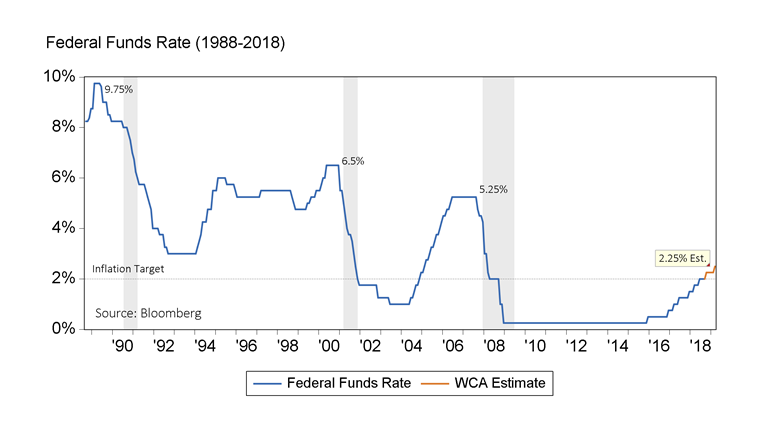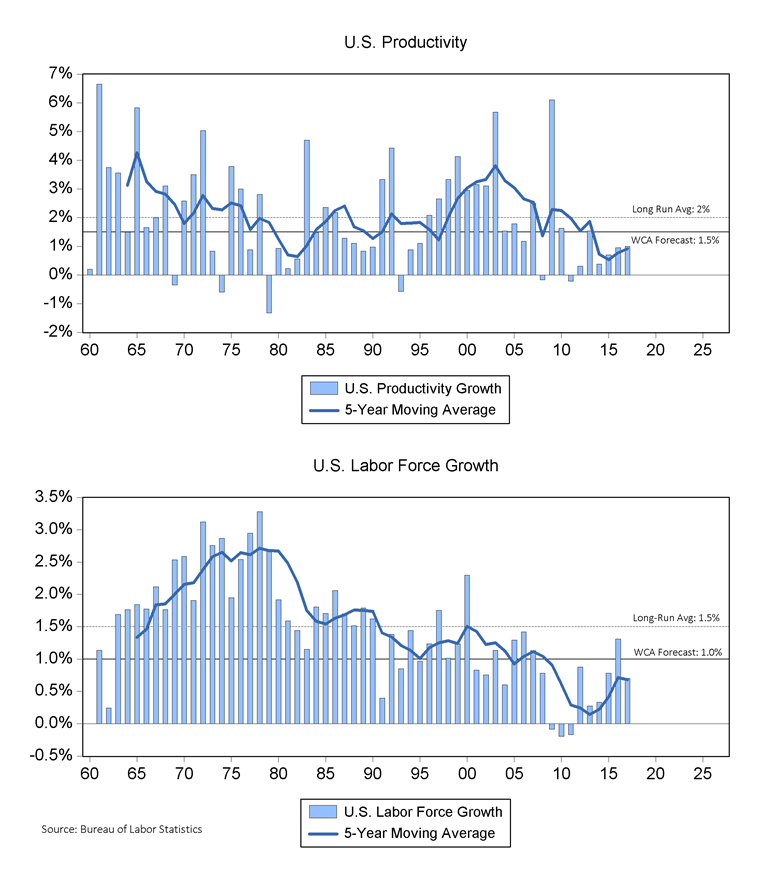Monday Morning Minute ~ October 1, 2018
Ten Years After
Looking back over the past ten years, the U.S. economy and stock market emerged as unlikely winners. A decade ago, Lehman Brothers and dozens of other financial firms were in the midst of collapse. In short order, the financial system and economy entered into a very dark period, culminating in a deep and painful recession. Equity markets fell by over 50% and 8.7 million Americans lost their jobs as the unemployment rate soared to 10%. From those depths, a recovery took hold and led to an expansion which endures today. Employment rolls are again full, as 20 million net new jobs were added since 2008. American wealth has also returned to record levels. According to the Federal Reserve, United States’ household net worth now stands at $106 trillion, up over 80% from the 2008 low water mark. Stock market indices are again at records and the S&P/Case Shiller 20 City Home Price Index is back to levels not seen since 2006.
A Changing Policy Backdrop
The initial rise in asset values following the crisis eased pressure on the economy and financial system. Fewer leveraged borrowers were driven into forced liquidations as asset values grew. This was helpful to both the borrower and the borrower’s financial institution. At the time of the crisis, a significant expansion of borrowing and spending by the government was called for to right the ship. Extraordinary monetary policy measures were also implemented including cutting short-term interest rates to zero and massive purchases of public and private assets. The combination of these measures helped create an environment conducive to risk taking, which helped jumpstart the recovery.
Today, the pendulum has swung the other way, and some of these policy measures no longer seem appropriate. Employment is full, confidence surveys are near records, asset prices are up, and inflation is beginning to firm. The Federal Reserve’s own estimates see current economic growth running hot relative to sustainable long-run growth, and inflation is also expected to run slightly above target. At 2.25%, short-term interest rates are broadly in line with the inflation rate but remain well below past rate cycle peaks (chart, below). Therefore, we expect the Federal Reserve will further raise overnight lending rates, lifting our expected return on cash and other high-quality, short-term instruments.

High-Level Capital Market Assumptions
Looking ahead, we expect positive, but lower, returns from equities. Our latest “base case” estimate calls for roughly 5-5.25% long-run equity returns, 2.5% long-run Treasury bond returns, and cash returns near 2.8%. Key to this outlook is the return to a better growth trajectory for the United States economy. After a long period of declining capital investment, labor force, and productivity trends, we expect to see some improvement back toward historic levels.
Long-Run Economic Assumptions
Investment: Aging infrastructure in productive capacity and public infrastructure raise the relative attractiveness of investment in new equipment and infrastructure. Recent tax reform provides an incentive for capital investment through accelerated depreciation and lower business tax rates, and we are seeing rising trends in capital goods and business investment.
Labor: Tighter labor markets are also encouraging formerly discouraged workers to come back into the labor force. With improved participation rates, we are estimating long-run labor force growth near 1% annually. If achieved, this would fall short of the long-run historic average, but be somewhat better than the post-financial-crisis years.
Productivity: We see tentative signs that productivity may begin to firm up. For most of the past 50 years, productivity in the United States rose about 2% per year. Since the great recession, that growth fell to roughly 0-1%. We see no reason why productivity growth will not be gradually drawn back toward historically normal levels over time, encouraged by ongoing discovery and development of new and emerging technologies.

Combining 1% estimated long-run labor force growth with 1.5% estimated long-run productivity growth suggest economic growth potential near 2.5%, before inflation. Adding a 2-2.25% inflation expectation to this forecast translates to total growth in the 4.5-4.75% range. This range is lower than past decades, but somewhat higher than the post-crisis years.
Tactical Portfolio Posture
Overall equity exposure is close to benchmark weight, given current neutral readings from our WCA Fundamental Conditions Barometer. Largely because we see better domestic growth than overseas, we are maintaining a domestic tilt as we start the quarter. Furthermore, we currently estimate a better reward-versus-risk trade-off in developed markets versus emerging markets. The domestic equity portion of portfolios is now biased toward the value style versus growth, given more favorable estimated valuations among value-oriented sectors. Except for a small bias toward shorter-duration along the curve, fixed income allocations remain close to benchmark allocations as most risk premiums remain compressed.
Kevin Caron, CFA, Senior Portfolio Manager
Chad Morganlander, Senior Portfolio Manager
Matthew Battipaglia, Portfolio Manager
Suzanne Ashley, Analyst
(973) 549-4168
www.washingtoncrossingadvisors.com
www.stifel.com
Disclosures
WCA Fundamental Conditions Barometer Description: We regularly assess changes in fundamental conditions to help guide near-term asset allocation decisions. The analysis incorporates approximately 30 forward-looking indicators in categories ranging from Credit and Capital Markets to U.S. Economic Conditions and Foreign Conditions. From each category of data, we create three diffusion-style sub-indices that measure the trends in the underlying data. Sustained improvement that is spread across a wide variety of observations will produce index readings above 50 (potentially favoring stocks), while readings below 50 would indicate potential deterioration (potentially favoring bonds). The WCA Fundamental Conditions Index combines the three underlying categories into a single summary measure. This measure can be thought of as a “barometer” for changes in fundamental conditions.
The information contained herein has been prepared from sources believed to be reliable but is not guaranteed by us and is not a complete summary or statement of all available data, nor is it considered an offer to buy or sell any securities referred to herein. Opinions expressed are subject to change without notice and do not take into account the particular investment objectives, financial situation, or needs of individual investors. There is no guarantee that the figures or opinions forecasted in this report will be realized or achieved. Employees of Stifel, Nicolaus & Company, Incorporated or its affiliates may, at times, release written or oral commentary, technical analysis, or trading strategies that differ from the opinions expressed within. Past performance is no guarantee of future results. Indices are unmanaged, and you cannot invest directly in an index.
Asset allocation and diversification do not ensure a profit and may not protect against loss. There are special considerations associated with international investing, including the risk of currency fluctuations and political and economic events. Investing in emerging markets may involve greater risk and volatility than investing in more developed countries. Due to their narrow focus, sector-based investments typically exhibit greater volatility. Small company stocks are typically more volatile and carry additional risks, since smaller companies generally are not as well established as larger companies. Property values can fall due to environmental, economic, or other reasons, and changes in interest rates can negatively impact the performance of real estate companies. When investing in bonds, it is important to note that as interest rates rise, bond prices will fall. High-yield bonds have greater credit risk than higher-quality bonds. The risk of loss in trading commodities and futures can be substantial. You should therefore carefully consider whether such trading is suitable for you in light of your financial condition. The high degree of leverage that is often obtainable in commodity trading can work against you as well as for you. The use of leverage can lead to large losses as well as gains.
All investments involve risk, including loss of principal, and there is no guarantee that investment objectives will be met. It is important to review your investment objectives, risk tolerance and liquidity needs before choosing an investment style or manager. Equity investments are subject generally to market, market sector, market liquidity, issuer, and investment style risks, among other factors to varying degrees. Fixed Income investments are subject to market, market liquidity, issuer, investment style, interest rate, credit quality, and call risks, among other factors to varying degrees.
This commentary often expresses opinions about the direction of market, investment sector and other trends. The opinions should not be considered predictions of future results. The information contained in this report is based on sources believed to be reliable, but is not guaranteed and not necessarily complete.
The securities discussed in this material were selected due to recent changes in the strategies. This selection criteria is not based on any measurement of performance of the underlying security.
Washington Crossing Advisors LLC is a wholly owned subsidiary and affiliated SEC Registered Investment Adviser of Stifel Financial Corp (NYSE: SF).
The S&P CoreLogic Case-Shiller 20-City Composite Home Price NSA Index is a value-weighted average that seeks to measure the value of residential real estate in 20 major U.S. metropolitan areas. The index is a composite of single-family home price indices for the nine U.S. Census divisions.



